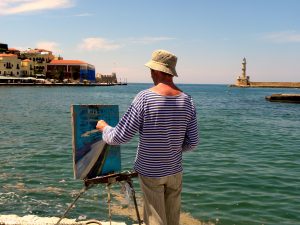Sonic Canvases: How Contemporary Artists Merge Music and Visual Art


In the ever-evolving landscape of artistic expression, the intersection of music and visual art has become a fertile ground for innovation and creativity. Contemporary artists are increasingly breaking down the traditional boundaries between these two forms, creating what can only be described as sonic canvases. This fascinating convergence of auditory and visual elements not only challenges conventional notions of art but also offers a multi-sensory experience that resonates with audiences on a profound level.
The Rise of Synesthesia in Art
Synesthesia, a neurological phenomenon where stimulation of one sensory pathway leads to involuntary experiences in another, has long inspired artists. However, this phenomenon has taken on a deliberate and conscious form in the contemporary art scene. Artists seek to evoke a sensory fusion by translating musical elements into visual representations and vice versa.
Musical Scores as Visual Blueprints
One of the most intriguing ways artists merge music and visual art is by using musical scores as visual blueprints. Traditionally confined to the realm of musicians, sheet music is now finding its place on the canvases of visual artists. With their intricate notations and symbols, these scores serve as both inspiration and foundation for creating visually stunning artworks.
Contemporary artist Stephen Malinowski takes this concept to new heights with his Music Animation Machine. He transforms musical compositions into dynamic, moving images through animated classical music visualizations. This approach enhances the listener’s understanding of the music and provides a visually immersive experience that adds a new layer of meaning to the auditory journey.
Interactive Installations: A Symphony of Senses
The advent of technology has played a pivotal role in the evolution of sonic canvases. Interactive installations responding to sound and touch have become a hallmark of contemporary art. Artists create environments where viewers can see and hear the art and actively participate in its creation.
For instance, the collaborative efforts of artist Rafael Lozano-Hemmer and composer Sabrina Schroeder resulted in “33 Questions per Minute.” This interactive installation invites participants to manipulate light and sound intensity through their movements. As viewers engage with the piece, they become co-creators, blurring the lines between the artist, the artwork, and the audience.
Synesthetic Expressions in Modern Music Videos
In the digital age, music videos have become a prominent canvas for the fusion of music and visual art. Many contemporary musicians collaborate with visual artists to create videos that transcend mere accompaniment to the music, turning them into full-fledged synesthetic experiences.
Take Björk, whose music videos often feel like immersive art installations. Collaborating with visionary directors and visual artists, her videos are rich tapestries of color, movement, and symbolism, mirroring the sonic complexity of her music. Through these visual interpretations, the audience gains a deeper understanding of the artist’s intent and emotions.
Cross-Disciplinary Collaborations: Breaking Down Barriers
The collaboration between musicians and visual artists is not limited to the digital realm. Many artists actively seek cross-disciplinary collaborations to explore the symbiotic relationship between music and visual art. These collaborations often result in groundbreaking performances that blur the boundaries between live music and immersive visual experiences.
A Harmonious Fusion of Artistic Realms
In the realm of sonic canvases, contemporary artists weave a rich tapestry transcending individual art forms. The fusion of music and visual art births a new language, speaking to the interconnected nature of human perception and creativity. As technology advances and artists push traditional mediums’ boundaries, the landscape of sonic canvases will undoubtedly evolve, offering audiences ever-deeper and more immersive artistic experiences. In this harmonious fusion of artistic realms, the boundaries between sight and sound blur, giving rise to a new era of multisensory exploration.
